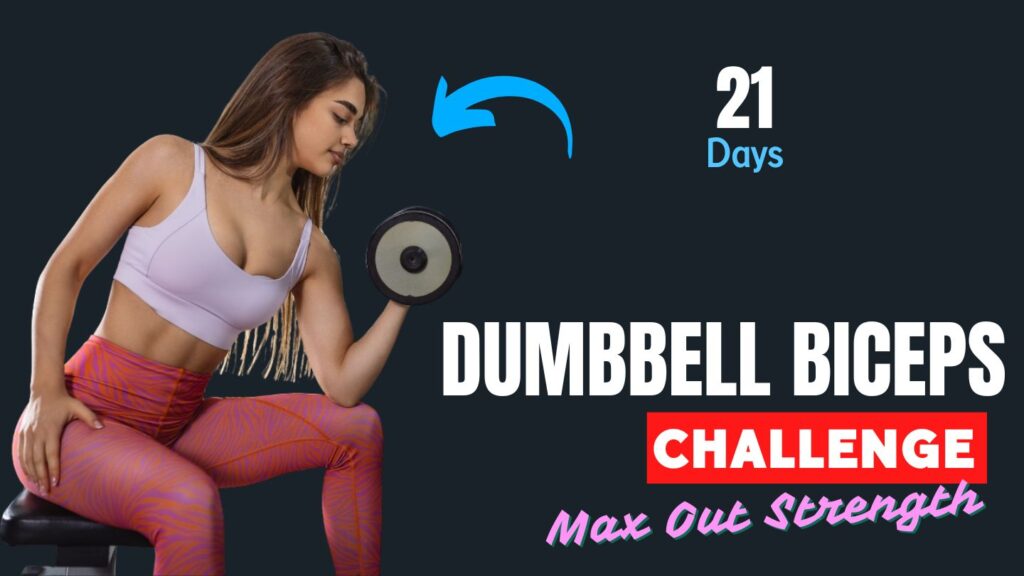Some links in this post are affiliate links. If you make a purchase through these links, I may receive a small commission. This helps support the site at no extra cost to you.
What if you could see a noticeable difference in your biceps in just 21 days? For many fitness enthusiasts, sculpted and powerful arms represent strength, confidence, and dedication.
Yet, most people either overtrain their biceps with endless curls or neglect the muscle completely, thinking it will grow passively from back workouts.
Here’s the truth: to maximize biceps size and strength, you need the right blend of exercise variation, progressive overload, and proper technique.
That’s exactly what this 21-Day Dumbbell Biceps Challenge delivers. Whether you train at home or in the gym, you’ll rely only on dumbbells, making it accessible yet powerful.
Did you know?
The biceps are actually a relatively small muscle compared to the triceps. In fact, the triceps make up nearly two-thirds of your upper arm mass. But because the biceps sit front and center, they play a big role in how strong and aesthetic your arms look.
In this program, you’ll learn 8 essential dumbbell exercises with step-by-step “how-to” guides, discover the right training volume, and follow a day-by-day 3-week challenge designed to push your growth to the next level.

Table of Contents
Why Focus on the Biceps?
The biceps brachii consists of two heads – the long head and the short head. Together, they are responsible for:
- Elbow flexion (bending the arm)
- Forearm supination (turning the palm upward)
- Shoulder flexion (raising the arm forward)
Training the biceps is not just about looks. Strong biceps improve pulling strength, help prevent elbow injuries, and enhance performance in compound lifts like pull-ups, rows, and deadlifts.
What Can Happen After 30 Days of This Biceps Challenge
| Positive Outcomes | Possible Risks (if not done correctly) |
|---|---|
| Noticeable increase in arm strength and curl performance. | Risk of elbow or wrist strain if form is poor. |
| Improved biceps size and definition. | Muscle imbalance if other body parts are neglected. |
| Stronger grip and forearm development. | Overtraining fatigue if rest days are ignored. |
| Better mind-muscle connection and control during lifts. | Plateau in progress if weights are not gradually increased. |
| Enhanced endurance for longer sets and higher reps. | Risk of shoulder tension if posture is compromised. |
| Visible arm vascularity with proper diet and consistency. | Possible joint discomfort without proper warm-up and recovery. |
Do’s and Don’ts of the 21-Day Dumbbell Biceps Challenge
| Do’s | Don’ts |
|---|---|
| Warm up your arms and shoulders before starting the workout. | Don’t lift weights that are too heavy and compromise your form. |
| Focus on slow, controlled movements to engage the biceps fully. | Don’t swing your body or use momentum to curl the weights. |
| Maintain a strong mind-muscle connection with every rep. | Don’t rush through sets just to finish quickly. |
| Increase dumbbell weight gradually for progressive overload. | Don’t stick to the same weight throughout the entire 21 days. |
| Prioritize recovery with proper rest and nutrition. | Don’t train biceps every single day without rest—it can cause injury. |
| Track your progress (weights, reps, arm measurements). | Don’t ignore pain signals—stop if you feel sharp or unusual pain. |
The 8 Core Dumbbell Exercises for Biceps Growth
Below are the exercises you’ll be rotating through the 21-day challenge. Each includes a short description followed by a step-by-step “how-to” guide.
1. Dumbbell Bicep Curl (Classic Builder)
Why: The foundation of all biceps training. This move directly targets both heads of the biceps.
How to:
- Stand tall holding a dumbbell in each hand with palms facing forward.
- Keep elbows close to your torso.
- Curl the weights upward, squeezing at the top.
- Slowly lower to starting position.
Tip: Avoid swinging your body. Keep the movement slow and controlled for maximum muscle activation.
2. Hammer Curl (Forearm & Brachialis Builder)
Why: This variation emphasizes the brachialis (a muscle beneath the biceps) and forearms, helping your arms look thicker.
How to:
- Hold dumbbells with palms facing each other (neutral grip).
- Keep elbows tucked in and curl the dumbbells up.
- Pause at the top and lower under control.
Fact: Building the brachialis pushes the biceps upward, creating the illusion of bigger arms.
3. Zottman Curl (Two-in-One Strengthener)
Why: A hybrid exercise that combines a bicep curl with a reverse curl to hit both biceps and forearms.
How to:
- Curl dumbbells up with palms facing forward.
- At the top, rotate wrists so palms face downward.
- Slowly lower in this reverse curl position.
4. Incline Dumbbell Curl (Peak Isolator)
Why: Performed on an incline bench, this move stretches the long head of the biceps, helping to build that coveted peak.
How to:
- Sit on an incline bench (about 45 degrees) with dumbbells in each hand.
- Let arms hang fully extended.
- Curl dumbbells upward while keeping elbows stationary.
- Lower slowly to full stretch.
Myth Busted: Many believe only genetics determine your bicep peak. While genetics play a role, smart training like incline curls can enhance it significantly.
5. Concentration Curl (Focused Isolation)
Why: This is one of the most effective exercises for isolating and contracting the biceps fully.
How to:
- Sit on a bench, spread your legs, and hold a dumbbell in one hand.
- Rest your elbow on the inside of your thigh.
- Curl the dumbbell upward slowly, squeezing at the top.
- Lower under control.
6. Cross-Body Curl (Arm Shaper)
Why: Also called the “Arnold curl,” this variation works the brachialis and gives your arms more fullness.
How to:
- Hold dumbbells at your sides with palms facing inward.
- Curl one dumbbell across your body toward the opposite shoulder.
- Lower and repeat on the other side.
7. Dumbbell Reverse Curl (Forearm Fortifier)
Why: Often neglected, this move strengthens the brachioradialis (top of forearm) and adds overall arm density.
How to:
- Hold dumbbells with palms facing down (overhand grip).
- Curl weights upward while keeping wrists straight.
- Slowly lower to the start.
8. Dumbbell Drag Curl (Hidden Growth Secret)
Why: Unlike standard curls, drag curls shift emphasis to the long head of the biceps, improving arm thickness.
How to:
- Hold dumbbells at your sides with palms facing forward.
- Instead of curling in front, pull the dumbbells straight up by dragging them along your torso.
- Squeeze at the top, then lower slowly.
Fact: Many old-school bodybuilders swore by drag curls to unlock arm growth when progress stalled.
The 21-Day Dumbbell Biceps Challenge
Now that you know the moves, it’s time to put them together in a structured 21-day progression plan.
Training Guidelines:
- Frequency: 5 training days per week (2 rest days)
- Sets & Reps: 3–4 sets per exercise, 10–15 reps
- Rest Between Sets: 60–90 seconds
- Progression: Increase weight slightly each week if form is solid
- Optional: Pair this challenge with compound pulling exercises (like rows or pull-ups) for maximum growth
Weekly Structure
| Day | Exercises | Sets x Reps | Notes |
|---|---|---|---|
| Day 1 (Strength) | Dumbbell Bicep Curl, Hammer Curl, Zottman Curl | 4 x 10–12 each | Heavier weights, strict form |
| Day 2 (Endurance & Pump) | Incline Dumbbell Curl, Concentration Curl, Cross-Body Curl | 3 x 12–15 each | Focus on slow tempo & squeeze |
| Day 3 (Rest/Recovery) | – | – | Stretch, foam roll arms |
| Day 4 (Power & Thickness) | Drag Curl, Hammer Curl, Reverse Curl | 4 x 10–12 each | Control negative (eccentric) phase |
| Day 5 (Isolation Blast) | Concentration Curl, Incline Curl, Dumbbell Curl | 3 x 12–15 each | Drop sets optional |
| Day 6 (Mix & Burnout) | All 8 exercises in a circuit (1–2 rounds) | 12 reps each | Keep rest minimal for pump |
| Day 7 (Rest) | – | – | Active recovery (light cardio or yoga) |
Repeat this weekly structure for 3 consecutive weeks.
Additional Tips for Maximum Biceps Growth
- Mind-Muscle Connection: Focus on feeling the biceps contract rather than just moving the weight.
- Progressive Overload: Even small dumbbell increases (1–2 kg) will trigger growth.
- Tempo Training: Slow down the eccentric (lowering) phase to maximize tension.
- Nutrition: Aim for adequate protein (1.6–2g per kg bodyweight) and overall calorie surplus if your goal is size.
- Recovery: Muscles grow during rest, not just training—sleep at least 7–8 hours.
Conclusion: What Comes After 21 Days?
Completing the 21-Day Dumbbell Biceps Challenge is not just about bigger arms—it’s about building consistency, discipline, and learning how to train your muscles with purpose.
In just three weeks, you’ll likely see more definition, stronger curls, and better control over your form.
But here’s the real secret: this challenge is only the beginning. Biceps, like any muscle group, need continuous progression to keep growing. After completing this plan, you can:
- Restart the challenge with slightly heavier dumbbells to push new strength gains.
- Expand the program by pairing it with triceps or back-focused workouts to balance overall arm development.
- Increase intensity by adding advanced techniques such as drop sets, supersets, or time-under-tension methods.
- Transition into a full 6-week or 12-week arm program that cycles through strength, hypertrophy, and endurance phases.
Think of the 21 days as your launchpad. The real transformation happens when you continue building on this momentum, setting new goals, and challenging your muscles in fresh ways.
Your next step? Repeat the challenge, but level it up—add more weight, increase your reps, or shorten your rest periods.
By stacking these 21-day cycles, you’ll not only grow bigger biceps but also create a habit of long-term progress that keeps you motivated and unstoppable.
Frequently Asked Questions (FAQs)
Can beginners do this 21-Day Dumbbell Biceps Challenge?
Yes, beginners can absolutely follow this program. Start with lighter dumbbells and focus on form before increasing weight.
How heavy should my dumbbells be?
Choose a weight that allows you to complete 10–15 reps with good form, but feels challenging by the last 2–3 reps of each set.
Do I need to work out every single day for results?
No. The challenge is designed with rest days to allow recovery and growth. Training biceps daily can actually lead to overtraining and injury.
Can I combine this challenge with other workouts?
Yes, and it’s encouraged. Pair this challenge with back, chest, or leg workouts for a balanced routine. Just avoid training biceps intensively right before or after heavy pulling days.
Will this program only build biceps size, or strength too?
Both. The exercises focus on hypertrophy (muscle growth) and strength by combining classic curls with variations that improve endurance and thickness.
What if I don’t see results after 21 days?
Results vary by diet, genetics, and consistency. If your form and effort are correct, you should notice improved strength and muscle tone. For more size, continue into a longer program with progressive overload.
Do I need any equipment besides dumbbells?
No. This challenge is designed to be done with just dumbbells, though an adjustable bench can be helpful for incline curls.
How much rest should I take between sets?
Rest 60–90 seconds between sets. For endurance days, you can reduce rest to 45–60 seconds to maintain the pump.
Can women also do this challenge?
Yes. This challenge is suitable for both men and women. Women will not “bulk up” unnaturally—dumbbell training will tone and strengthen the arms.
What should I eat to maximize biceps growth?
Focus on a balanced diet with lean proteins, complex carbs, and healthy fats. Aim for 1.6–2g of protein per kilogram of body weight daily.










